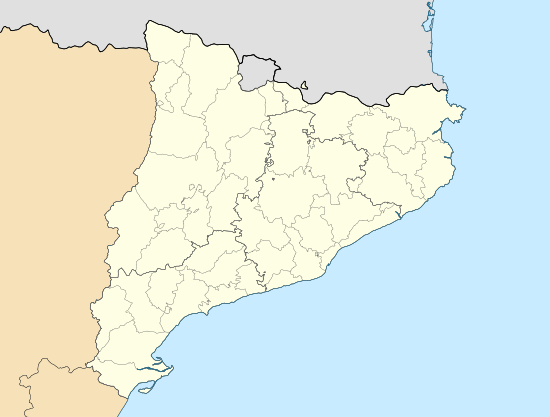Horta de Sant Joan
| Horta de Sant Joan | |||
|---|---|---|---|
| Municipality | |||
|
Horta de Sant Joan | |||
| |||
 Horta de Sant Joan Location in Catalonia | |||
| Coordinates: 40°57′23″N 0°18′59″E / 40.95639°N 0.31639°ECoordinates: 40°57′23″N 0°18′59″E / 40.95639°N 0.31639°E | |||
| Country |
| ||
| Community |
| ||
| Province | Tarragona | ||
| Comarca | Terra Alta | ||
| Government | |||
| • mayor | Joaquim Ferràs Prats (2015)[1] | ||
| Area[2] | |||
| • Total | 119.0 km2 (45.9 sq mi) | ||
| Elevation | 542 m (1,778 ft) | ||
| Population (2014)[1] | |||
| • Total | 1,219 | ||
| • Density | 10/km2 (27/sq mi) | ||
| Climate | Csa | ||
| Website |
www | ||
Horta de Sant Joan is a village in the Terra Alta of Catalonia, Spain.
The village of Horta de Sant Joan, sometimes called Orta, is located in a picturesque spot on a hill with a view of the landscape of the northwestern foothills of the mountain range called the Ports of Beceite. The Saint Salvador d'Horta monastery, also known as Convent of Angels, is located at the foot of Santa Barbara Mountain, a rocky hill of striking appearance.[3]
The spectacular rock formations called Benet's Rocks are located within Horta de Sant Joan's municipal area. Benet's Rocks form the most characteristic overall landscape in the northern section of the mountain range. Of the three large rock forms, the left-most one is referred to as the Dog's Head because when viewed from the side it strongly resembles that form.
Much of Horta de Sant Joan is within the Natural Park of the Ports of Beseite. The area outside the park boundaries is mostly agricultural, with large tracts of olive, almond, and fruit trees, as well as vineyards. The main economic activity of the area is agriculture, including livestock (mostly sheep and goats), and there is also a lot of tourism and construction.
There are three major rivers crossing the area around Horta. First is the Algars which forms the boundary between the Terra Alta in Catalonia and the Matarranya in Teruel. The next river is the Estrets, which cuts through a rocky canyon, forming pools and drops in a stunning landscape before joining the Algars River just above the town of Lledo, at Rose's springs. The third river is the Canaletes, in the east, which later joins the largest river in Spain, the Ebro.
Horta de Sant Joan enjoys an Interior Mediterranean climate, with very cold winters and extremely hot summers. The area benefits from the Ports Mountain range, which traps cooler sea air from the coast and brings a natural form of "air conditioning" in the evenings in the summer called the Garbi for the winds from the east by that name.
Because of its location on a small hill with a natural spring near the top, Horta has been inhabited for centuries. It was a great advantage during medieval sieges, to not be forced to get water from the rivers outside of town. The earliest inhabitants were Iberians, who lived in the area until the arrival of the Romans. In the 8th century Horta, like most of Spain, was under Muslim rule, then reconquered by Christians in the 12th Century. There are still olive trees, like the 1,000-year-old Parot, that were planted by the Muslims during their 400-year rule.
Horta de Sant Joan is the birthplace of Manuel Pallares, friend and companion of Pablo Picasso. Picasso spent some time in Horta during his youth (1897–98) with his friend Manuel. He is quoted as having said, "Everything I know I learned in Horta". Picasso later returned to develop his Proto-Cubism style of painting (1909). During both visits he made a lot of paintings and drawings. There is currently a Centro Picasso (Picasso Center) that organizes expositions, symposiums, publications, etc.; Also there is an Eco-Museum of the Natural Park of the Ports, and a visitor's center with maps and hotel information.
Villages
- Horta de Sant Joan, 1,234
Notable people
- Gerard Badía (born 18 October 1989), Spanish footballer
References
- 1 2 "Ajuntament d'Horta de Sant Joan". Generalitat of Catalonia. Retrieved 2015-11-13.
- ↑ "El municipi en xifres: Horta de Sant Joan". Statistical Institute of Catalonia. Retrieved 2015-11-23.
- ↑ Horta de Sant Joan Tourist Office
External links
| Wikimedia Commons has media related to Horta de Sant Joan. |
- Pàgina web de l'Ajuntament
- Informació de la Generalitat de Catalunya
- Informació de l'Institut d'Estadística de Catalunya
 |
Arens de Lledó (Aragon) | Caseres | Bot |  |
| Lledó (Aragon) | |
Prat de Comte Paüls | ||
| ||||
| | ||||
| Arnes | Alfara de Carles |


